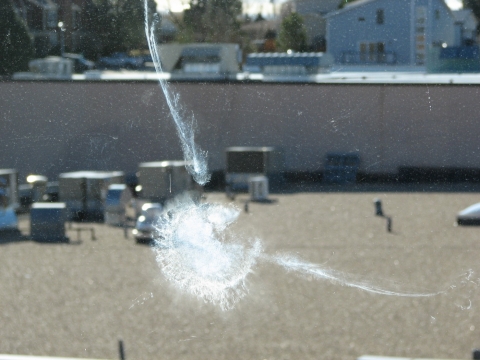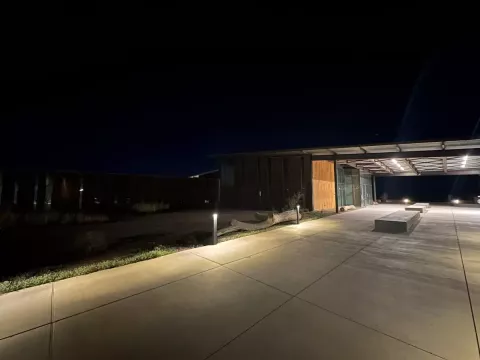Nighttime lighting and glass are significantly increasing on the landscape, contributing to an alarming rise in bird fatalities, and negatively impacting other wildlife, human health, energy use, carbon footprints, and our ability to enjoy the night sky.
It is estimated that approximately 1 billion birds fall victim to fatal collisions each year in the United States alone. The increased use of glass in modern buildings and homes, along with the already-existing glass on the landscape, present an especially serious collision hazard to birds, who do not perceive glass as an obstacle and often fly towards reflections of what may appear to be natural habitat like plants or the sky.
Light pollution and lit infrastructure can further exacerbate this by disorienting birds during their nocturnal migration, exhausting them as they circle lit structures and ultimately leading them closer to the threat of colliding with glass and buildings. From neotropical bird species that travel thousands of miles each fall and spring between continents, to common backyard birds and game species, these threats are impacting a diverse range of native birds. Many of these species, such as the golden-winged warbler and evening grosbeak, are Birds of Conservation Concern, meaning that without focused conservation attention, these species could decline to the point where they would be considered for protection under the Endangered Species Act.
The good news is that these threats are preventable and there are plenty of simple actions we can all take to make a big difference! Many of the proposed solutions are also consistent with protecting the night skies, human health, and energy efficiency. However, despite available solutions and shared goals, widespread adoption and implementation has been slow, and the risks for birds and night skies continue to grow. Through strategic partnerships and investments, it is possible to significantly reduce the risk for future bird collisions and night skies and provide solutions for a wide variety of structures that will remain on the landscape for years to come.
Recognizing this, the U.S. Fish and Wildlife Service Migratory Bird Program hosted a “Multi-Sector Summit to Address Light Pollution and Bird Collisions” at our National Conservation Training Center in February of 2024. Through this Summit, stakeholders from all aspects of these issues came together to discuss the state of the science, learn from our diverse partners’ perspectives, and strategize next steps through the lens of social science and strategic communications.
Some of the world’s foremost experts on these issues, innovators who are developing solutions, pioneers that are forging a path for us to follow, and celebrities who are championing conservation issues inspired a room full of participants to take action and collaborate on developing strategies.
This Summit was the first of its kind: a symposium that brought together researchers, medical doctors, engineers, city planners, architects, lighting specialists, conservation groups, federal agencies, various industries, and social scientists to discuss the effects of lights at night on bird migration, dark skies, collisions, as well as human health and safety. Using collaborative breakout sessions led by facilitators, participants identified barriers, opportunities, and solutions to reduce nighttime lighting and reflective glass for the benefit of communities and birds.
We shared how there are numerous federal office buildings, National Wildlife Refuges and National Parks that have already made their windows and skies bird-safe, with more retrofits planned this year. We also heard personal testimonials on the successful efforts to build partnerships and address the collisions that occur each year during the 9/11 Tribute of Light Memorial.
The Summit provided a way to share success stories that will inspire further action. From the individuals who made their homes and buildings bird-safe, to major cities across the country successfully implemented bird-safe building standards and the growing number of cities participating in Lights Out for Birds programs, momentum to address these preventable threats is growing.
Special thanks to our partners at the Cornell Lab of Ornithology and their Center for Conservation Media Producer Daniel Sheire for screening their new Lights Out Texas film, featuring scientists and professionals working to reverse the trend of bird loss in Texas:
Testimonials
“An incredible event that brought together like-minded people from the various wildlife conservation sectors for the first time. The presentations were informative and thought-provoking, spurring on many conversations during the multi-day event. The event itself was extremely well put together, and the USFWS National Conservation Training Center was the perfect venue. I came away with a feeling of this being the start of something very big, I look forward to the next event and many more.” - Paul Groleau, Vice President of Feather Friendly Technologies
"Thanks to Director Williams and her team for their leadership convening this inspiring and much-needed summit. Spending time with scientists, advocates and volunteers, industry leaders, and government partners gives me hope that we will all work together to give birds peace to navigate the earth, reduce harmful lights and glass, and let the stars shine." - Jane Alexander, Global Wildlife Ambassador, Former Chair of the National Endowment for the Arts, Actress, and Author
“USFWS’s collisions summit was a great event because the Service was able to bring together a diverse group of professionals who work on lighting design, building design, material design, advocacy, legislation, and more - a group that almost certainly would not have come together as they did if just about anyone but the USFWS had extended the invitation. Not only were the sessions informative and idea sparking, looking around at the conversations between and after sessions it was clear that excellent new relationships were being formed, relationships that are sure to save birds from collisions.” - Bryan Lenz, American Bird Conservancy
"It's so heartening to see momentum building to protect our birds and our skies across the public, private, nonprofit, and research sectors," said David Jeffrey Ringer, founding partner at Green Jay Strategies. "The leadership of the U.S. Fish and Wildlife Service is vital, and if all of us work together and take these issues seriously, we can make a big difference." - David Ringer, Green Jay Strategies
Next Steps
A unifying theme emerged throughout these impactful three days:
It will take intentional collaboration among this diverse group of partners (and others that we still need to reach) to ensure bird-friendly practices are implemented at meaningful scales.
This means that our work is really just beginning. We are extremely pleased with the outcomes of these efforts and look forward to continuing the momentum in working with partners to protect, restore, and conserve bird populations and their habitats for the benefit of future generations.
If your organization would like to join this community of practice to address both light pollution and bird collisions, please reach out to Joelle_Gehring@fws.gov.
We invite everyone to share their expertise and become part of the solution.
To learn more about these threats to birds and what you can do to help in your community, check out the latest NCTC podcast episode “Birds in Flight: Migration and it’s Perils” featuring two Migratory Bird Program biologists, our suite of Bird Collision Reduction Toolkits, and the Cornell Lab's Lights Out for Birds BirdCast migration forecast tools!
“Birds in Flight: Migration and it’s Perils”
Bird Collision Reduction Toolkits










